
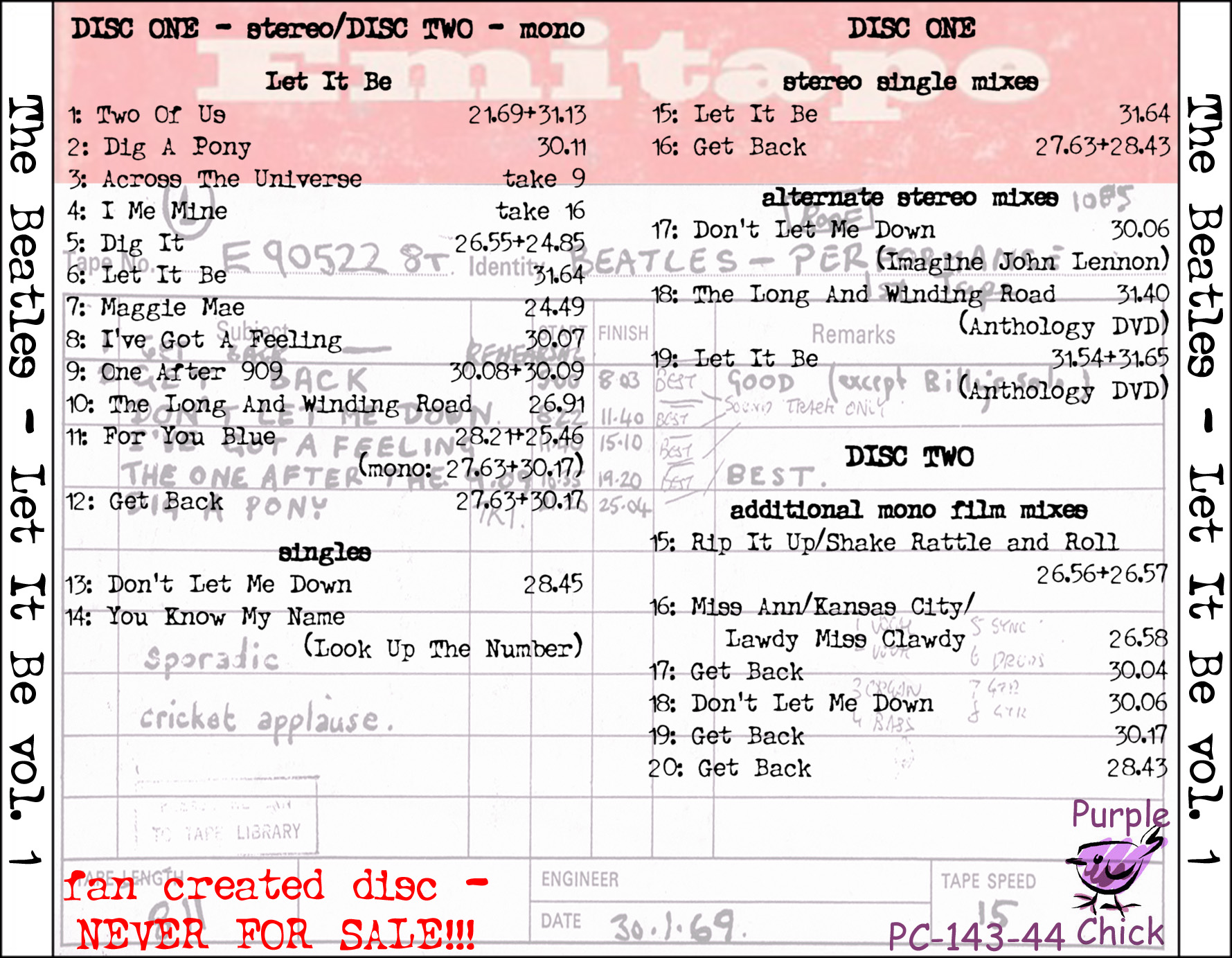


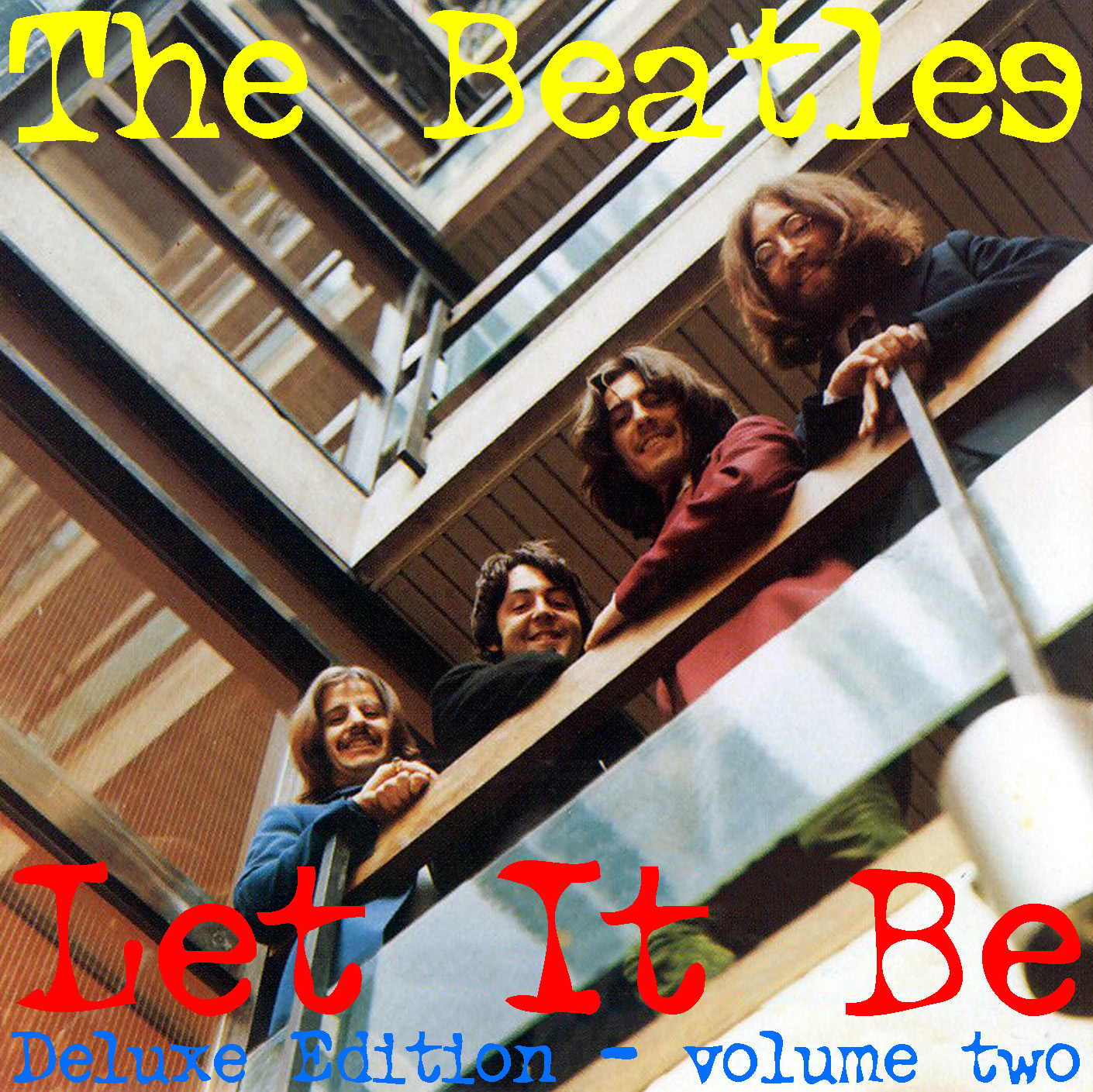
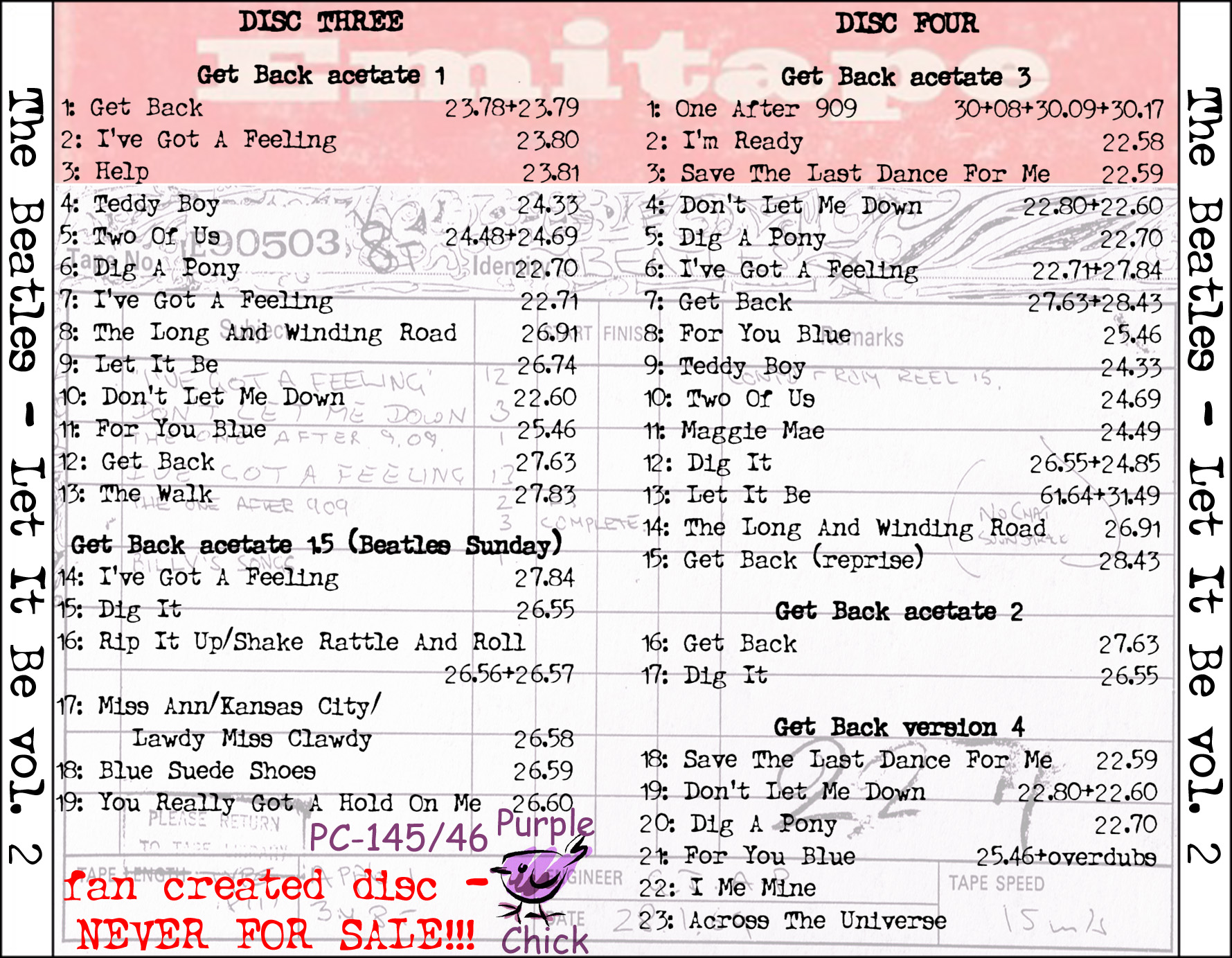
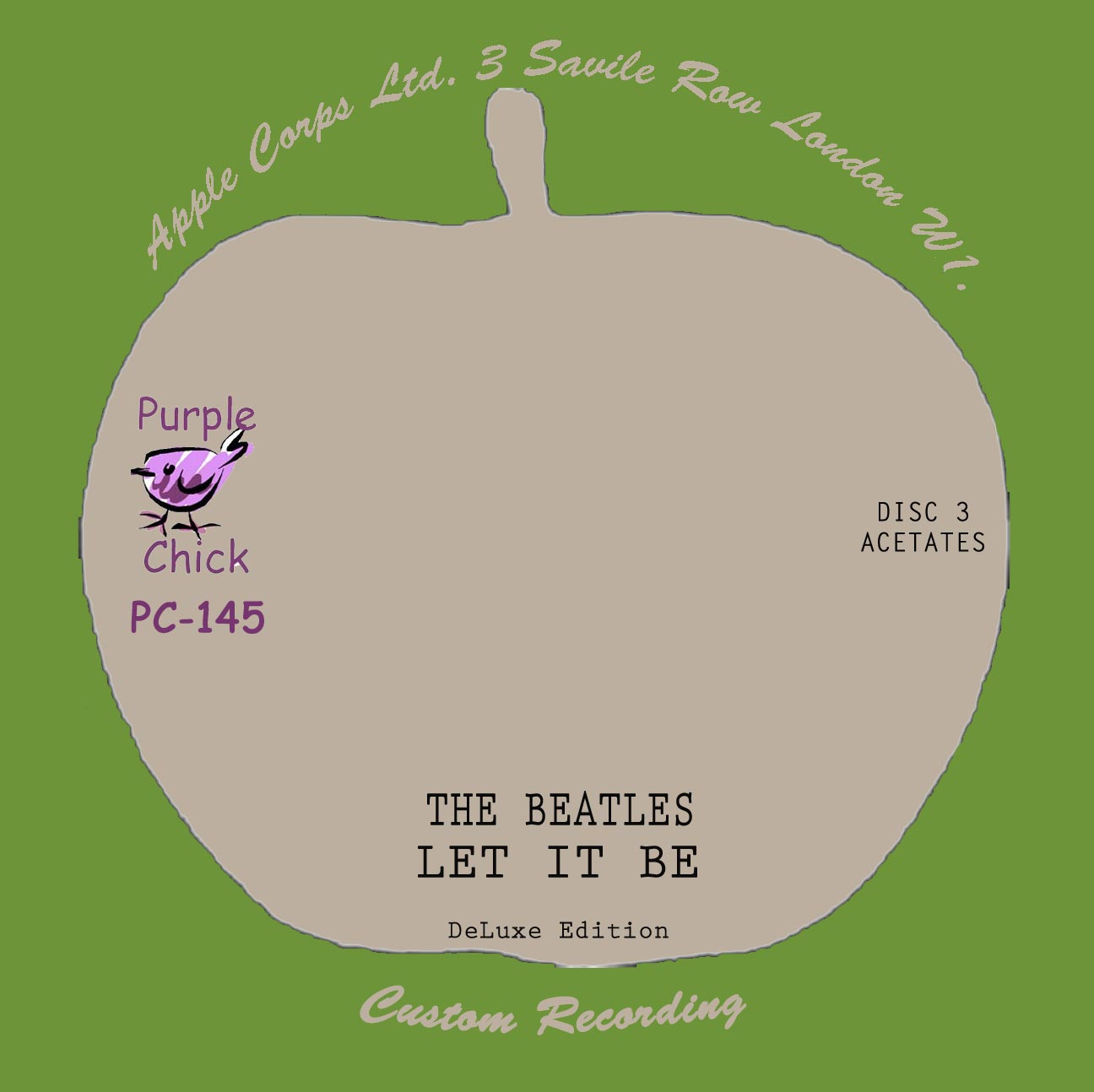


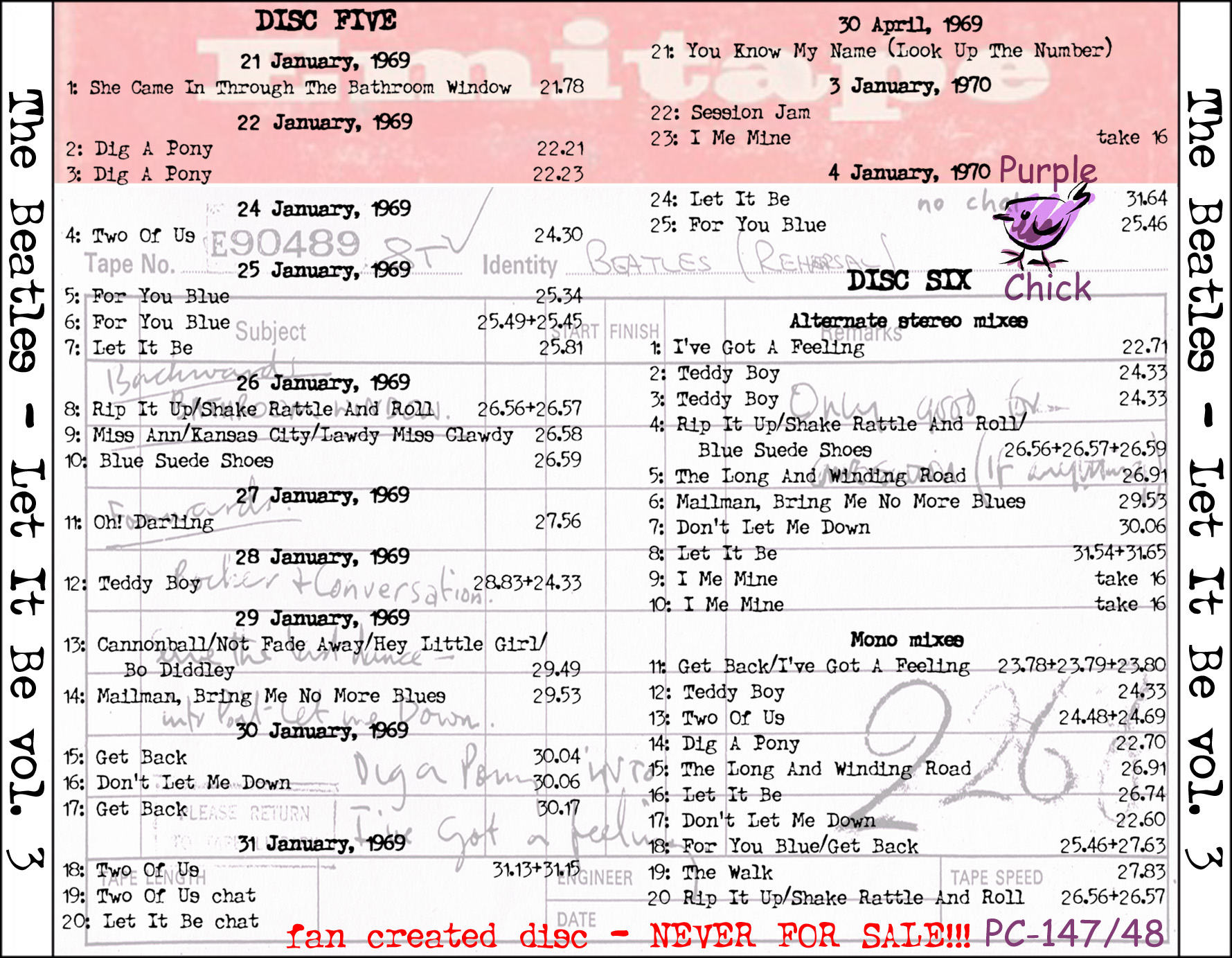
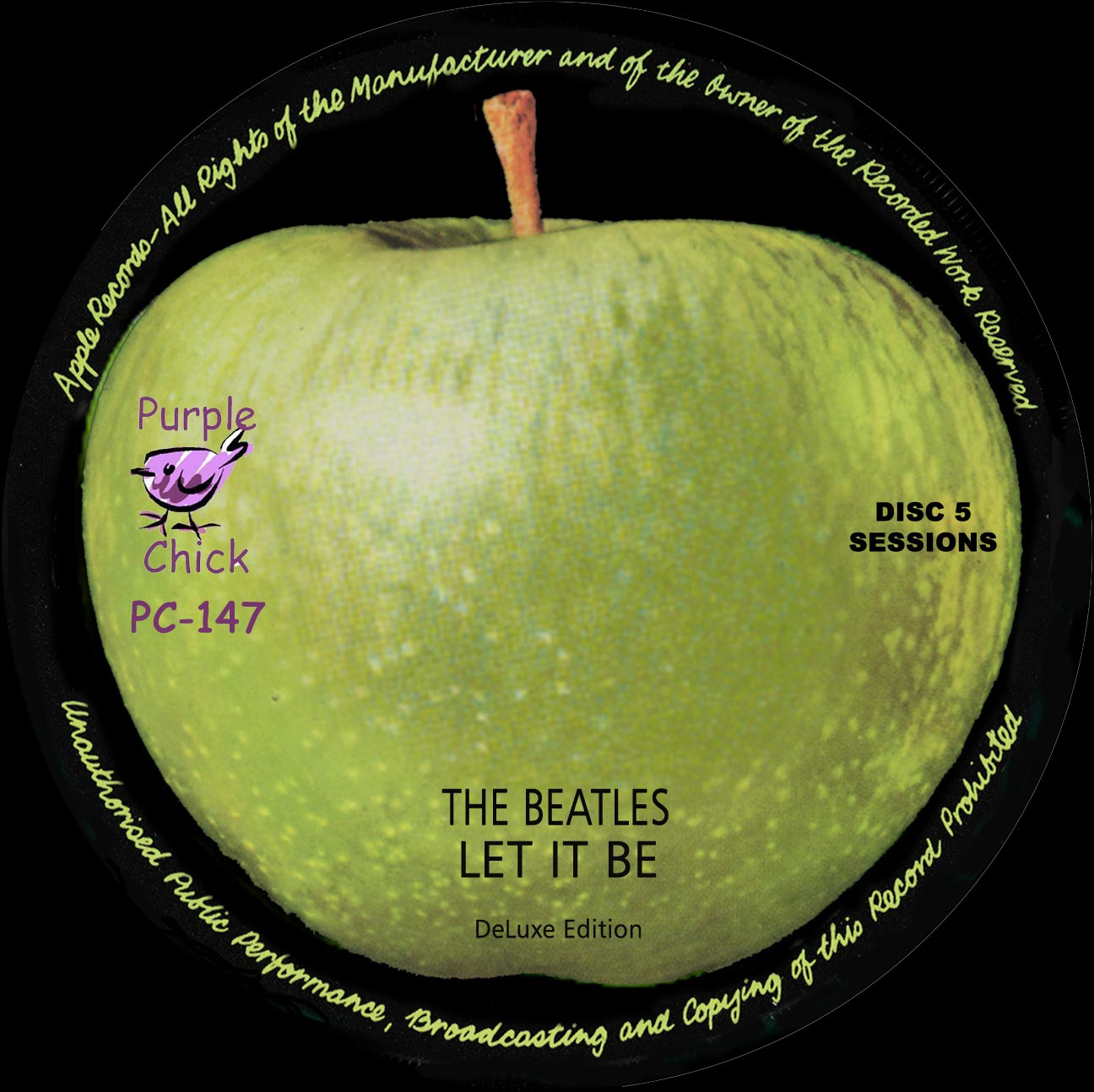

BOOKLET
================
Let It Be: Notes
================
Lineage: SilverCDs–> EAC(secure)–> Flac–> Demonoid
.. contents::
Purple Chick’s Deluxe Edition of Let It Be is six discs of material almost entirely from January 1969. The first two discs are the released and mostly finished (but unreleased) tracks in stereo and mono. Discs three and four are compilations of mixes made by Glyn Johns throughout 1969 and into 1970 (aka. the Get Back Acetates), while the final two discs are session outtakes and alternate mixes.
Many of the take numbers on this set are “DDSI numbers”, from Doug Sulpy and Ray Schweighardt’s “Drugs, Divorce And A Slipping Image”, a book that I don’t own that was first published in 1988 chronicling the recording sessions of January 1969. It used numbers in the form XX.YY to refer to the takes; XX being the day it was recorded and YY the song or take number from that day. So 27.63 is the 63rd song recorded on January 27 1969. The book was revised (including some of the DDSI numbers) and published as “Get Back
– The Beatles’ Let It Be Disaster” in 1997, and a revised list of numbers was published in Doug Sulpy’s “The Complete Get Back Sessions” in 2001 — this would appear to be the version referred to by Purple Chick in this set. (The book has been revised and re-released under its original title on November 15 2007, so looks like the numbers will change again…)
Completists will want to check out Purple Chick’s A/B Road, a complete set of session tapes from the Get Back / Let It Be sessions. These were preserved on hundreds of mono tapes (called “Nagra reels”) recorded for use on the film soundtrack. Two different recorders were running, resulting in “A” and “B” rolls of tape, each one 16 minutes long. Purple Chick has compiled these into a single, sequential, 83 disc set which regularly pops up on the usual places on the Internet … (http://www.thetradersden.org/forums/showthread.php?t=34245)
Volume One: The Masters And The Mixes
————————————-
Disc 1: Stereo
…………..
Volume One begins with the twelve tracks from the Let It Be album, in stereo, sourced from Dr. Ebbetts’ transfer of the “Blue Box” remasters set. This is the album as prepared by Phil Spector in March and April, 1970; for Glyn Johns’ compilations, see `Volume Two: The Acetates`.
Track 13 is the 1969 stereo mix of Don’t Let Me Down, prepared for use on the flip side of the Get Back single in the United States. This was the Beatles’ first stereo single in the US, but in the UK and most other places they would have to wait six more weeks for The Ballad Of John And Yoko to be their first stereo single.
Track 14 is You Know My Name (Look Up The Number), a track first began in 1967, completed in 1969, and finally released as side B to the Let It Be single in 1970. This song was never mixed into stereo in the classical era, but finally received its first stereo mix in 1995 for Anthology 2, used here. (Mixes made after 1971 or so, which I consider the end of the “classical era”, are usually numbered with the last two digits of the year they were made. In this case it wasn’t made until 1995 so the mix is numbered RS95.)
This is followed by the stereo single mix of Let It Be, released in March 1970. Although it uses the same basic recording as the version of the song heard on the album, this mix differs mostly in the guitar solo (it uses the April 1969 overdub and not the January 1970 one) and is edited differently.
Track 16 is the stereo single mix of Get Back, made for the 45rpm release in the United States. Again, this differs from the mix used on the album (I suppose to make it sound like a different take), in this case it includes the coda after the “woo” (the album version ends after the “woo” which was the true end of the song and then cuts into dialogue from the Rooftop Concert).
The next track is an alternate mix of the rooftop performance of Don’t Let Me Down used on Imagine: John Lennon, made in 1988 for the documentary of the same name.
Finally are three alternate stereo mixes from the Anthology DVD set: The Long And Winding Road, Let It Be and the customary medley of mix fragments.
Disc 2: Mono
…………
Even though there was no mono release of the album Let It Be, the songs that were recorded to eight-track tape and heard in the film were mixed into mono for the film’s soundtrack. Purple Chick has used the movie soundtrack, where available, to create the mono version of Let It Be that appears on Disc 2.
Some fragments of dialogue were taken from the Nagra film tapes, and these are noted in the inside of the cover for Volume One. Maggie May is entirely from the Nagra reels, and so is For You Blue (a mono mix from the eight-track tape wasn’t made of this song for the movie). Across The Universe is the stereo mix, sped up to run at its original speed. I Me Mine is an alternate stereo mix taken from an acetate. Get Back is the original UK single mix in mono (and so sounds more like the US stereo single mix on track 16 of Disc 1 than the album mix).
These twelve songs are followed by the mono mix of Don’t Let Me Down, made for the B-side of the Get Back single for release in the United Kingdom (EMI was still releasing singles in mono at this point in 1969).
Next up is the original mono mix of You Know My Name (Look Up The Number), made and edited by John Lennon as a possible A-side to a Plastic Ono Band single (the B-side being the White Album-era recording of What’s The New Mary Jane), but eventually released in 1970 as the flip side to the Let It Be single. Both the 1995 stereo and 1969 mono mixes are edited: for details and a complete take see track 21 on Disc 5.
The disc winds up with six additional mono mixes created from eight-track tape for the movie soundtrack.
A complete mono Let It Be can be found on Purple Chick’s own A/B Road, recreated using the live-to-mono Nagra reels (and probably sounds better than the mono version heard here, even though the multitrack tapes weren’t used). Just about every other mono release of Let It Be has been made by folding-in the stereo mixes, so Purple Chick doesn’t bother using them on this Deluxe Edition. (Dr. Ebbetts, for one, has a transfer of Let It Be that was released in Brazil in folded-in mono and sounds pretty good.)
Volume Two: The Acetates
————————
Disc 3: Get Back 1 & The Oldies
………………………….
This is the first compilation prepared by Glyn Johns of the Get Back sessions. The songs were all mixed from the eight-track tapes on January 24, 25 and 27 1969, and the acetate containing them was probably cut on January 30 — the same day as the Rooftop Concert.
Three of the takes used on Compilation 1 — The Long And Winding Road (track 8, take 26.91), For You Blue (track 11, take 25.46) and Get Back (track 12, take 27.63) — were eventually used on the released Let It Be album (with overdubs, edits and of course new mixes). Also included are Teddy Boy, which would be left off of Let It Be and re-recorded for Paul’s first solo album, a cover of Jimmy McCracklin’s The Walk and a brief snippet of Help!.
Conspicuous in their absence are One After 909 which wouldn’t be recorded until the Rooftop Concert, I Me Mine which was heard in the film but not properly recorded until 1970 and Across The Universe which was also in the film and prepared from the 1968 recording.
These tracks were mixed in stereo, and the source used here has preserved those mixes. This Compilation was only used as a guide for the Beatles and never intended for release.
“Get Back 1-1/2” is the oldies compilation, prepared by Glyn Johns from eight-track tape around the same time as Compilation 1, and also includes fragments of I’ve Got A Feeling and Dig It. You Really Got A Hold On Me fades, returns to full volume, then abruptly cuts off before the end. (This could be how it was recorded onto the eight-track tape. It’s near the end of tape E90495, although John C. Winn indicates that Tracks Of My Tears was recorded after this but never mixed). These songs were almost certainly
mixed into stereo by Glyn Johns, but somewhere along the bootleg chain they have been folded into mono. This acetate was probably also intended as a reference, and the songs were probably meant to be used as linking tracks in the final album.
Disc 4: Get Back 2, 3 & 4
…………………….
The bulk of this disc is Compilation 3; however, the same mixes were used on Compilations 2 and 4. Circulating copies of Compilation 3 just happen to have the best sound quality.
Compilation 2 was mixed on April 3, 4 and 7 and May 2 1969, and was the prototype for a potential Get Back album (but probably not intended for release). Acetates containing this compilation were cut on May 7 and 9 1969.
Compilation 2 includes One After 909 and Maggie May for the first time, as well as partial covers of I’m Ready and Save The Last Dance For Me. Tracks 16 and 17 are the only mixes unique to Compilation 2 — Get Back lacks either the rooftop chatter of the album version or the coda of the single version, and Dig It is nearly a minute longer than the version heard on the other Compilations. Somewhere along the bootleg chain these have been reduced to mono, but only one channel of the stereo recording was preserved.
Compilation 2 was well received but rejected in favour of more interspersed dialogue, so Glyn Johns returned to Olympic Studios on May 15 1969 to produce Compilation 3. This is predominantly the same as Compilation 2, except Dig It has been trimmed by a minute and Get Back is similar to the single mixes. Otherwise it was cut to acetates on May 28 and announced for release in August, then September and finally December 1969. Due to its longevity, this could be considered the Get Back album that was meant to be released
(or the original version of Let It Be … Naked).
(Speaking of `Let It Be … Naked`, none of those tracks appear on any of the Deluxe Editions. Purple Chick expects that we all own it already, which is true, right?)
This copy of Compilation 3 was taken from Vigotone’s Thirty Days bootleg release, which is from a copy of tapes AR14271 and AR14272 (and not from acetate sources of Compilation 3).
By December it was apparent that Teddy Boy would not appear in the movie, but Across The Universe and I Me Mine would. Thus, on December 15 and 21, Glyn Johns began work on a fourth compilation of songs for the project. On one of these dates he obtained the four-track tape containing Across The Universe and created a new mix similar to the early 1969 songs (he left in the “you’re right, Richie” at the start and mixed out any backwards instruments and most of the backing vocals).
On the other hand, no take of I Me Mine had been recorded to multi-track tape, so on January 3 and 4 1970, George, Paul and Ringo convened at Abbey Road Studios to participate in what would be their last sessions together as The Beatles for another 24 years. (Ringo recorded additional material on April 1 for Across The Universe, The Long And Winding Road and I Me Mine, but with several choral and orchestral musicians and no other Beatles. John had left for a vacation and was not present). I Me Mine was
mixed on January 5 with some studio chat from the January 3 session.
Also remixed was For You Blue, which had a new vocal overdubbed sometime in early January 1970 (at Olympic Studios, which was not as meticulous as Abbey Road in their record-keeping). Bootlegs include a heavily edited version of Save The Last Dance For Me, and it’s possible that Glyn Johns edited it this way for Compilation 4 (the edit is sloppy, but it removes even sloppier performances from the Beatles). Dig A Pony differs from Compilation 3 mostly in the tape startup sound at the beginning. Don’t Let
Me Down has dialogue mixed differently.
It doesn’t seem that Compilation 4 was ever cut to acetate, but was preserved on tapes AR16991 and AR16992. These didn’t appear on bootleg until 1999 and were sourced from cassette dubs made by John Barrett. Nearly a year after most of the tracks on it were laid down to tape, this compilation was dumped. And so was Glyn Johns: on January 27 1970, John recorded Instant Karma for the Plastic Ono Band with George Harrison on lead guitar and Phil Spector producing. Impressed with Spector’s work (as well as his resumé — after all, Spector’s own To Know Her Is To Love Her was an early stage favourite of the Beatles), they recruited him to finish the Let It Be album, which he began at Abbey Road Studios on March 23 1970 (coincidentally, Paul was there at the same time finalising his first solo album, McCartney — luckily they didn’t run into each other).
For those wondering what Compilations 2 and 4 might sound like with the proper track order, the following playlists based upon Disc 4 can be used:
Compilation 2
~~~~~~~~~~~~~
* Track 1 – One After 909
* Track 2 – I’m Ready (Rocker)
* Track 3 – Save The Last Dance For Me
* Track 4 – Don’t Let Me Down
* Track 5 – Dig A Pony
* Track 6 – I’ve Got A Feeling
* Track 16 – Get Back
* Track 8 – For You Blue
* Track 9 – Teddy Boy
* Track 10 – Two Of Us
* Track 11 – Maggie May
* Track 17 – Dig It
* Track 13 – Let It Be
* Track 14 – The Long And Winding Road
* Track 15 – Get Back (Reprise)
Compilation 4
~~~~~~~~~~~~~
* Track 1 – One After 909
* Track 2 – I’m Ready (Rocker)
* Track 18 – Save The Last Dance For Me
* Track 19 – Don’t Let Me Down
* Track 20 – Dig A Pony
* Track 6 – I’ve Got A Feeling
* Track 7 – Get Back
* Track 13 – Let It Be
* Track 21 – For You Blue
* Track 10 – Two Of Us
* Track 11 – Maggie May
* Track 12 – Dig It
* Track 14 – The Long And Winding Road
* Track 22 – I Me Mine
* Track 23 – Across The Universe
* Track 15 – Get Back (Reprise)
Volume Three: The Sessions And The Mixes
—————————————-
Disc 5: The Sessions
………………..
There’s hundreds of hours of recordings circulating from the Get Back sessions (sourced from tape reels from the film recording), nearly all of which can be found on Purple Chick’s own A/B Road release (an 83-disc set!), but this set concentrates on those recordings mixed from eight-track tape.
Disc 5 begins with a song that Paul wanted to demo for the group but ultimately wouldn’t be included on a Beatles recording until Abbey Road. This was She Came In Through The Bathroom Window, and was recorded on the first day of proper recordings at the group’s own Apple Studios on January 21 onto tape E90489. Recordings were to start on the 20th on equipment (including a 72-track tape recorder!) built by “Magic Alex” Mardas at Apple Electronics, but when it was discovered his promises far exceeded his skill
(allegedly after attempting to record on a crude mixing console he had built), the group was forced to borrow an eight-track recorder and two four-track mixing consoles from EMI (wasting a day’s work in the process). This session also saw the addition of one of the claimants to the title “Fifth Beatle”, Billy Preston. Billy had met the Beatles in 1962 when he was 16 years old and touring England with Little Richard’s band (the Beatles were the opening act). George re-encountered Billy at a Ray Charles concert
shortly after he briefly left the Beatles in mid-January, 1969, and when he was encouraged to return to the group he brought Billy with him in a successful bid to relieve tensions between the bandmembers. (Eric Clapton had a similar effect several months earlier during the recording of While My Guitar Gently Weeps).
The 22nd saw a couple dozen recordings of Dig A Pony, at least two of which were recorded to eight-track tape: take 22.21 which was recorded to tape E90489 and mixed for Anthology 3 and 22.23 (also on E90489) and heard on “The Boardroom Tape”, an off-line tape of alternate mixes presented to EMI executives around 1976 (after the expiry of the Beatles’ contract) for possible inclusion on a set of previously-unreleased Beatles material.
Track 4 is a recording of Two Of Us from January 24 (the same day that would record the take used on Glyn Johns’ compilations, but not Phil Spector’s) onto tape E90491. This was mixed for Anthology 3.
The group got serious with the recording of For You Blue on the 25th and several takes were committed to tapes E90493 and E90521, including the master (25.46, on Disc 1), track 5 (25.34, from Anthology 3) and track 6 (edit of 25.49 and 25.45, from a stereo mix made for an Apple promotional video). Let It Be was recorded to tape E90494 at least once this evening, but would be tried again the next day.
January 26 began with Ringo composing Octopus’ Garden with a little help from George, while most of the day was spent recording Let It Be. Before moving on to The Long And Winding Road (including the master take), they played a jam that evolved into Dig It (the master take), then switched to playing some oldies: the Beatles ran through a medley of Rip It Up and Shake, Rattle And Roll, both recorded by Bill Haley And The Comets (the former also by Little Richard). This was followed by a medley of songs recorded by Little Richard: Miss Ann, Kansas City (also covered by The Beatles in Little Richard’s style much earlier on Beatles For Sale; the Harrison in the credit is Wilbert Harrison who recorded the song in 1959 and whose version is closer to the one heard here) and Lawdy Miss Clawdy. Then they moved on to Carl Perkins’ Blue Suede Shoes (in Elvis’s style). Dig It (which appears elsewhere) and the oldies (tracks 8-10) were all recorded to tape E90495.
Track 11 is another song that would return during the Abbey Road sessions: Oh! Darling. This is especially notable for including vocals from both Paul *and* John, as well as John happily announcing that Yoko’s divorce has gone through. It was recorded on the 27th onto tape E90498 and would be followed later this day by the master take of Get Back (both the single and album edits).
Paul’s Teddy Boy was recorded several times throughout the sessions, and to multitrack tape at least twice: on the 24th and 28th. Track 12 is an Anthology 3 combination of humourous fragments from 28.83 (from E90504) over Glyn Johns’ master take 24.33 (from E90491, before the song was dropped from Glyn’s fourth compilation).
On the 29th the group committed a jam of a medley to eight-track tape E90505, consisting of Duane Eddy’s Cannonball, Buddy Holly’s Not Fade Away, Dee Clark’s Hey Little Girl and Bo Diddley’s self-named Bo Diddley. Clearly on a Buddy Holly kick (it being nearly a decade to the day of Holly’s death on February 3 1959 and also performing Maybe Baby, Peggy Sue Got Married and Crying, Waiting, Hoping on this day), the group continued with Mailman, Bring Me No More Blues. This was covered by Holly on the flip side to his
single Words Of Love (which itself was covered almost note-for-note by the Beatles on Beatles For Sale).
Finally the moment came to present the Get Back material to the world. George had already vetoed a concert performance, but keeping in spirit with the live feel of the material they decided to perform it from the roof of the Apple building. After warming up with two takes of Get Back followed by I Want You (She’s So Heavy) (yet another track destined for Abbey Road), they performed Get Back again — the performance captured to tape E90522, in a promotional video for the song, and here as track 15. Then they moved on to track 16, Don’t Let Me Down (this should be take 30.05, not 30.06 as noted in the liner notes). This was followed by the take of I’ve Got A Feeling used on the LP, then One After 909 (also used on the LP). (Given the past performances of this song dating back to 1963, it’s nice to see they finally got it right the first time through when it came to performing it live!) The group continues with Dig A Pony (once someone finds John a lyric sheet to read off of) which also winds up on the LP. It’s time to change tapes in the basement studio far below, so the group jams through God Save The Queen. After the intermission, they continue with more takes of I’ve Got A Feeling and Don’t Let Me Down which don’t improve on the spontaneous nature of the originals.
Track 17 is a historic moment: the last song played during the Beatles’ last live performance. By this point the police had made it to the roof and the group commits one last song to tape E90524 in an attempt to end the movie with the Beatles being arrested (alluded to by Paul near the end of the song). Mal Evans shuts down John and George’s amplifiers early, but Ringo and George have none of this and George turns them back on by the 43 second mark. The song ends with applause provided by the entourage on the roof and a cheer from Ringo’s wife Maureen (who is thanked by Paul). John makes the famous “I Hope We Passed The Audition” comment that was heard not only at the end of the Let It Be album but also many CD-Rs ago on the Purple Chick release of the same name …
The last day of January 1969 was reserved for recording songs that wouldn’t be used in the last live performance from the previous day. This included take 31.13 of Two Of Us which would be chosen by Phil Spector over a year later to open the Let It Be LP. Track 18 is this take edited with take 31.15, both of which were recorded on tape E90508. They would also record The Long And Winding Road (a mix of which is heard as track 18 on Disc 1 but couldn’t better the January 26th version) and Let It Be (ultimately destined for both the LP and a single, albeit with different overdubs in each case). Two Of Us is followed by two tracks of studio chat edited together from the master tapes and heard on the TV special for the 2006 Love release.
Track 21 is an edit of You Know My Name (Look Up The Number), combining the stereo mix from Anthology 2 and the mono mix from the flip side of the Let It Be single. This song has the distinction of sitting around for the longest time between being originally recorded and released (at least until Anthology came out). The first segment (intro) was begun on May 17 1967 (less than a month after Sgt. Pepper was finished and two weeks before its release) on tape E64380 and overdubs were added to take 9 on June 7 of that
year. Four more segments were recorded the next day onto tapes E64675 and E64676 with saxophone performance by the Rolling Stones’ multi-instrumentalist Brian Jones on part 2 (ska beat). Part 3 (Slaggers) followed, then part 4 (high voices). Finally part 5 (the ending) was put to tape with more saxophone from Brian Jones. The five parts were edited together on June 9 (the edit also placed on E64676) and called take 30. The song then sat on a shelf for nearly two years … until John was reminded of both it and What’s The New Mary Jane in late April 1969. He dusted it off shortly after George recorded the first of two guitar solos to Let It Be on April 30, and was joined by Paul for some fun vocals (the song would later be described by Paul as “his favourite Beatles track” and this session might have been the last time him and John really worked together in the studio). Three mono mixes were made, the third of which was preferred. Then the song went back to the shelf. On November 26 1969, John once again thought of What’s The New Mary Jane and this song, and dusted off the mix tape. He edited out nearly two minutes of material, including all of part 2 and a bit of part 3 and calling it mix RM4. The two songs went as far as having masters prepared for pressing as a Plastic Ono Band single, but perhaps realising Apple couldn’t release what were actually Beatles recordings in this way the single was cancelled. What’s The New Mary Jane would officially sit on the shelf for 25 years, but the mono mix of You Know My Name (Look Up
The Number) was pulled out to be the B-side of the Beatles’ last original single. A stereo mix of the whole song was finally prepared in 1995, but George (who obviously liked the song no more then than he did in 1969 when he declined to provide vocals) cut out nearly 30 seconds of part 4 and faded out the ending early. Fortunately, between the two mixes a complete performance exists, and that’s just what the bootleggers gave us on “Upgraded Collection – Highlights”.
Tracks 22 and 23 are from the second-to-last Beatles session as a group on January 3 1970, attended by George, Ringo and Paul (John had left with Yoko to spend New Year’s in Denmark with her daughter and ex-husband’s family). Or at least track 23 is known to be from this session; track 22 is a session jam reportedly from this day but without vocals or a detailed log of events it’s hard to say for sure. John C. Winn and Doug Sulpy believe it’s not the Beatles, but Purple Chick thinks it could be. It’s a pretty good jam and sounds better than just about anything the group created a year earlier, so either they really had it together this day, or it’s someone else playing …
track 23 is take 16 of I Me Mine in its original length before being edited (and overdubs added) by Phil Spector. George’s statement before the recording began refers not only to John’s absence from this session, but also the departure of “Dave Dee” Harman from the group Dave Dee, Dozy, Beaky, Mick & Tich a few months earlier. (The same three participants would return the next day to work on Let It Be in their last session together for 24 years).
Disc 5 ends with two outfakes created by Purple Chick. Track 24 is Let It Be with both guitar solos. The April 30 1969 solo was used on Glyn Johns’ second and third compilations as well as the single mix and is in the left channel, while the January 4 1970 solo was used on the LP mix and is in the right channel. Track 25 is the same process on For You Blue’s vocal track. The January 25 1969 vocal is in the left and was used on Glyn Johns’ compilations while the January 8 1970 vocal is in the right and was used on the Let It Be LP.
Disc 6: The Mixes
……………..
This disc is made up of alternate mixes from songs appearing elsewhere on this Deluxe Edition set. The first half is alternate stereo mixes (mostly from Anthology 3 or the original VHS release of Anthology), while the second is mono mixes (probably folddowns from stereo) of the first acetate prepared by Glyn Johns.
Tracks 2 and 3 are alternate mixes of Teddy Boy, both of the same take (24.33). The first is a mix made in 1970 by Phil Spector but left off the album (good thing, since Paul was recording a version for his self-titled solo debut album at almost the same time). The second is Glyn Johns’ unedited mix, nearly two minutes longer than the version used on the middle two of his Get Back compilation acetates.
This is followed by the January 26 medley of Rip It Up / Shake, Rattle And Roll edited with Blue Suede Shoes for Anthology 3. After this is the Anthology 3 mix of The Long And Winding Road, take 26.91 — the same take used (with lush orchestra) on Let It Be, this time “as nature intended” it (or at least as Paul intended it).
Track 6 is the Anthology 3 mix of Mailman, Bring Me No More Blues from January 29. This is followed by Anthology video mixes of Don’t Let Me Down (this is take 30.05, not 30.06 which was I’ve Got A Feeling) and Let It Be.
The stereo mixes are finished off by two alternate mixes of the raw take 16 of I Me Mine from January, 1970 (the first of which includes a heavily echoed take announcement).
Tracks 11 through 19 are likely stereo-to-mono fold-ins of a copy of the first Get Back compilation from tapes E69738 and E69739. Track 20 is a mix of Rip It Up / Shake, Rattle And Roll from The Boardroom Tape.
Let It Be… Naked
——————
(I was originally going to catalogue the differences between this album and the original LP in this section, but between coming up with the idea and actually writing it I received a copy of Volume Two of John C. Winn’s “The Beatles’ Recorded Legacy”. In Appendix D he’s provided a detailed description of each track and compares them to both Phil Spector and Glyn Johns’ mixes as well as going over the edits made in 2003. Those of you who have gladly listened to each disc in this series and want to know more would
do well to find copies of all three volumes of these books. Rather than duplicate his work — or plagiarise it — I’ll simply provide an overview of the major differences for those who have this disc:)
In 2003 the long awaited “De-Spectorised” version of Let It Be was released as Let It Be … Naked, giving us yet another variant of the Get Back material. This was mixed and produced by Paul Hicks (son of the Hollies’ guitarist Tony Hicks), Guy Massey and Allan Rouse (who digitally copied all of the Beatles’ existing studio tapes for Anthology and is probably only the second person after John Barrett to hear nearly all of those tapes) at Abbey Road Studios. It stays truer to Glyn Johns’ mixes by avoiding all of Phil Spector’s overdubs, but unfortunately loses the “warts-and-all” approach by also removing the inter-track banter and false starts. The sound itself has been criticised due to the perceived over-use of digital effects such as noise reduction (and possibly auto-tuning).
The takes chosen are predominantly the same as those used on the LP, but the track order has been changed a bit. This album starts off with Get Back (rather than ending it like the LP), and is the same take, faded early. Dig A Pony is the same performance and has mostly the same edits as the LP. For You Blue uses the 1970 vocal overdub. The Long And Winding Road is a completely different performance: the one used in the film (and Anthology DVD mix on Disc 1), take 31.40 (presumably this was used at least in part to avoid duplicating the already de-Spectorised mix of take 26.91 on Anthology 3). Two Of Us is nearly identical to the LP, only the fact that it’s clearer gives it away as a new mix. I’ve Got A Feeling is a composite of the two rooftop performances (the LP consists only of the first).
One After 909 is again the rooftop performance, but is (like Two Of Us) somewhat clearer sounding than the LP and compilation mixes. Don’t Let Me Down appears as part of an album’s running order for the first time since Glyn Johns’ compilations, but this time it’s a combination of the two rooftop performances (to avoid John’s vocal flubs in the last verse). I Me Mine has a new edit to extend the length of take 16. Across The Universe is the same take 7 from 1968 used everywhere, but lacks the backwards instruments and backing vocals from 1968, the wildlife sounds added sometime in 1968 and 1970 orchestral overdubs. It also ends with an amazing fade of John’s vocal. The album ends with Let It Be, mostly from the same performance used on the LP and single (31.64) including 1970 vocal and bass overdubs, but also with elements from the performance used in the film (31.65) including that take’s guitar solo.
All in all, a nice alternate take on Let It Be — somewhat closer to the original Get Back idea, even if it doesn’t quite live up to its title. Let It Be … Naked also comes with a bonus disc of extracts from the film’s Nagra reels (entirely in mono) titled “Fly On The Wall”. Too bad the movie itself hasn’t been released on DVD yet …
(If you’ve read this far and don’t have Let It Be … Naked on CD, just go out and buy it. Seriously, with all the money you saved by Purple Chick giving away all these session outtakes, alternate mixes and vinyl transfers, you should be able to afford all the Beatles’ officially released CDs. Okay, maybe not the single and EP sets, those are supposed to be quite pricey and rare and I don’t own them either. But the 1992 EMI EP collection had superior tape transfers than the 1987 CDs, and these were also used on the “Red” and “Blue” album re-releases on CD in 1993 so you may as well get them, too. And Yellow Submarine Songtrack, even though Purple Chick included all the mixes from it on the Deluxe Editions …)
Bibliography
————
The Beatles Complete U.K. Discography
http://www.jpgr.co.uk/
The Beatles Deluxe Editions By Purple Chick
http://x3mkungen.mine.nu/wogev/beatles/pc/index.html
The Beatles Recording Sessions Update
http://reunionsessions.tripod.com/al/faabsessions/contents.html
The BeatleSource
http://www.beatlesource.com/
http://www.beatlesource.com/bs/mains/audio/GetBack/gb2intro.html
BootlegZone
http://www.bootlegzone.com/
Brennan, Joe. The Usenet Guide to Beatles Recording Variations
http://www.columbia.edu/~brennan/beatles/
Drugs, Divorce and a Slipping Image (website only)
http://www.dougsulpy.com/dougsulpy.com/Doug%20Sulpy.html
The Get Back Rehearsals
http://www.maccafan.net/Gallery/GetBackRehearsals/Twickenham.htm
Lewisohn, Mark. The Beatles Recording Sessions
Lewisohn, Mark. The Complete Beatles Chronicle
Ryan, Kevin and Kehew, Brian. Recording The Beatles
Wikipedia
http://en.wikipedia.org/wiki/The_Beatles
Winn, John C. (ed.). John Barrett’s Notes
Winn, John C. Lifting Latches: The Beatles’ Recorded Legacy
http://members.aol.com/multiplusbooks/
